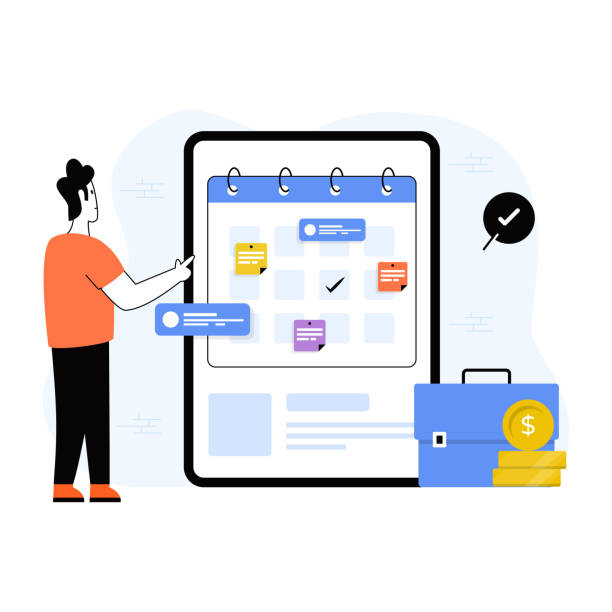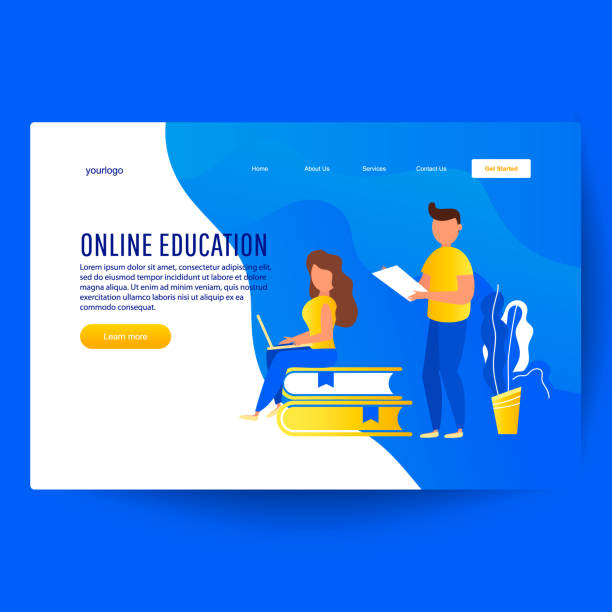An Introduction to the Importance of Modern User Interface Design in Web
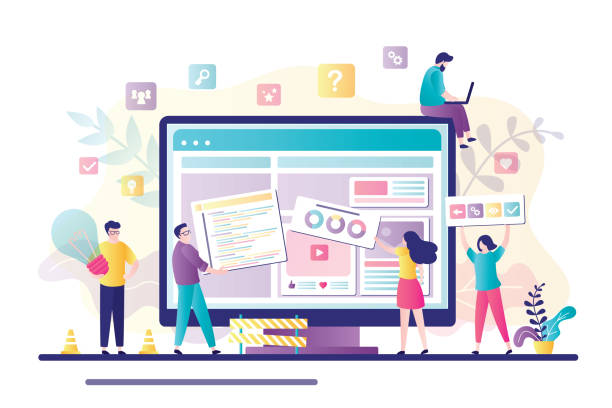
In today’s digital world, where competition for user attention intensifies by the moment, #Modern_User_Interface is no longer merely a luxury option, but a vital necessity.
The first #Impression users have of a website plays a decisive role in their continued interaction.
An outdated or unfriendly user interface can quickly drive visitors away from your website and towards your competitors.
Therefore, Modern Website Design with a Modern User Interface has become a focal point for many businesses and developers.
This approach is not limited to visual aesthetics but focuses on efficiency, ease of use, and the overall User Experience (UX).
A modern design provides an intuitive and enjoyable path for users to achieve their goals on the website, whether it’s purchasing a product, finding information, or communicating.
This type of design goes beyond fleeting trends, addressing fundamental user needs and helping to create a meaningful interaction by applying principles of cognitive psychology and consumer behavior.
The importance of this issue is such that investing in it not only leads to an improved customer retention rate but also significantly strengthens a business’s credibility and branding.
A deep understanding of user expectations and technological developments is the cornerstone of a successful design that can distinguish your website among a multitude of digital platforms.
With technological advancements and increased internet speed, users expect websites to be not only fast and responsive but also to provide a pleasant and interactive visual experience.
Ignoring these aspects can lead to customer loss and reduced market share.
Therefore, attention to detail, including typography, color scheme, and whitespace, alongside performance optimization, is crucial to ensure your website is a powerful tool for achieving your business objectives.
To further understand user interface principles, you can refer to the User Interface page on Wikipedia.
This introduction serves as a justification for the importance of our explanatory and specialized approach throughout this article.
Are you dissatisfied with the low conversion rate of visitors to customers on your e-commerce site?
Solve this problem forever with professional e-commerce website design by Rasaweb!
✅ Increase visitor-to-customer conversion rate
✅ Create an excellent user experience and build customer trust
⚡ Get a free consultation
Key Principles in Designing User-Friendly and Engaging User Experiences

For a website to be truly modern and user-friendly, special attention must be paid to the key principles of #Ease_of_Use, #Responsiveness, and #Aesthetics.
These principles form the backbone of any #Modern_Website_Design_with_a_Modern_User_Interface and ensure that users can not only easily interact with your site but also enjoy the experience.
Ease of use means that users can quickly and intuitively achieve their goals without needing special training or guidance.
This includes easy navigation, logical organization of information, and simple processes for performing tasks (such as registration forms or purchases).
The less friction in the user’s path, the greater the likelihood of their success and satisfaction.
Responsiveness or “Responsive Design” is also of high importance.
Given the variety of devices users employ to access the internet – from desktops to mobiles and tablets – your website must be able to adapt its appearance and functionality to any screen size.
This feature not only improves the user experience but also impacts search engine rankings.
Google prefers responsive websites in mobile search results.
Aesthetics is the visual dimension of design, encompassing the selection of colors, fonts, images, and animations.
An attractive visual design can evoke positive emotions in users and convey a sense of trust and professionalism.
This beauty must be functional and clearly convey information, not merely for decorative purposes.
The appropriate use of whitespace for design breathing room, a harmonious color palette, and legible typography all contribute to creating a pleasant visual experience.
For more information on responsive design, you can refer to the Responsive Web Design page on Wikipedia.
Additionally, the main concept of user experience, which includes all these principles, is explained in detail on the User Experience page on Wikipedia.
These principles together provide a strong foundation for any website aiming to attract and retain users long-term.
New Tools and Technologies in User Interface Construction
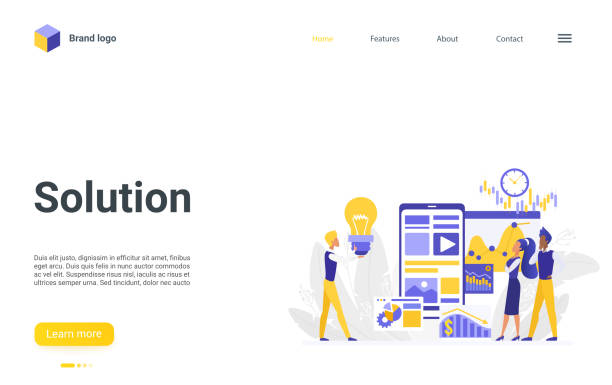
The world of #Web_Development and #UI_Design is rapidly evolving, with new tools and technologies constantly being introduced that make the process of #Building_Websites_with_Advanced_User_Experience more efficient and creative.
For any designer looking to implement a Modern Website Design with a Modern User Interface, familiarity with these tools is crucial.
In the #Specialized and #Guidance section of this article, we will cover some of the most important ones.
Among the most widely used tools for visual design are Figma, Adobe XD, and Sketch.
These tools enable high-precision design of wireframes, prototypes, and user interfaces and also offer team collaboration capabilities, which are very important for large projects.
Figma has gained significant popularity due to its cloud-native nature and real-time collaboration features.
On the other hand, for implementing and coding user interfaces, JavaScript #Frameworks and #Libraries play a significant role.
React (developed by Facebook), Vue.js, and Angular are among the most popular, helping developers to quickly build reusable and interactive user interface components.
These frameworks simplify the development of complex web applications by providing structured architectures.
For styling (CSS), using frameworks like Bootstrap or Tailwind CSS can accelerate the process of responsive and beautiful design.
Tailwind CSS, in particular, with its utility-first approach, offers great flexibility to developers.
Additionally, package management tools like npm and yarn and version control systems like Git are integral parts of the modern development process, facilitating collaboration and code change tracking.
The correct selection of these tools depends on project needs and team skills, but knowing them is essential for any designer and developer aiming to create an outstanding digital product.
| Category | Tool/Technology Name | Primary Use | Key Benefits |
|---|---|---|---|
| Visual Design and Prototyping | Figma | UI/UX Design, Wireframing, Prototyping | Real-time collaboration, Cloud-based, Diverse plugins |
| Frontend Frameworks | React | Building interactive and single-page application (SPA) user interfaces | Component-based, Large ecosystem, High performance |
| Frontend Frameworks | Vue.js | Building progressive and scalable user interfaces | Easy to learn, Lightweight, Flexible |
| CSS Frameworks | Bootstrap | Responsive and rapid design development | Complete set of ready-made components, Strong documentation |
| CSS Frameworks | Tailwind CSS | Utility-first styling | High flexibility, Less CSS volume, Development speed |
| Version Control Tools | Git | Managing and tracking code changes | Team collaboration, Reverting to previous versions, Code security |
The Impact of Modern Design on User Interaction and Business Success

The impact of #Modern_Website_Design on #User_Interaction and ultimately, #Business_Success, is undeniable.
A Modern Website Design with a Modern User Interface is not only an investment in aesthetics but also a smart strategy for improving #Conversion_Rates and increasing #User_Loyalty to the brand.
When a user enters a well-designed site with easy navigation and a visually pleasing interface, they feel more comfortable and trusting.
This positive experience leads to longer stays on the site, more page views, and a higher probability of performing desired actions, such as purchasing, signing up, or filling out a form.
Research has shown that websites with excellent user experience have lower bounce rates and significantly higher average time spent on page.
These metrics are also important for search engines and can help improve SEO rankings.
From a business perspective, a modern user interface directly impacts revenue.
For example, a simple and transparent payment process in an online store can drastically reduce shopping cart abandonment rates.
It also creates stronger and more distinct branding.
A website with a professional and up-to-date appearance enhances brand credibility and helps the company be recognized as a leader in its industry by the audience.
Conversely, a poor user interface can lead to customer loss, reduced sales, and damage to brand reputation.
For more information on the impact of user experience on business, you can refer to reputable articles on ROI of UX Design.
Investing in modern design is, in fact, an investment in the future of the business and in building a lasting relationship with customers.
This analysis shows that website design is not just an expense, but an asset that can bring significant value.
Ultimately, focusing on user experience becomes a competitive advantage that cannot be ignored.
Tired of losing customers due to poor e-commerce website design? With Rasaweb, solve this problem forever!
✅ Increase sales and visitor-to-customer conversion rates
✅ Smooth and engaging user experience for your customers⚡ Get a free consultation
Challenges Ahead in Implementing Advanced User Interfaces

Implementing a Modern Website Design with a Modern User Interface, while offering numerous benefits, also comes with unique challenges that must be carefully addressed.
One of the biggest challenges is ensuring #Browser_Compatibility.
With the wide variety of browsers (such as Chrome, Firefox, Safari, Edge) and their different versions, ensuring that the user interface displays correctly and functions uniformly across all of them is a complex task.
Differences in how CSS and JavaScript are rendered can lead to inconsistent displays and unexpected bugs.
This issue requires continuous and precise testing in various environments.
The second challenge is the issue of #Performance and website loading speed.
Modern user interfaces often use complex animations, high-quality images, and heavy JavaScript frameworks, which can lead to slow loading speeds.
Today’s users expect high speed, and even a few seconds of delay can lead to site abandonment.
Image optimization, reducing the size of CSS and JavaScript codes through Minification (removing whitespace and extra characters) and Compression (compressing files), are among the effective solutions used to combat this challenge.
The issue of #Security is also a fundamental concern.
As user interfaces become more complex and their interaction with servers increases, new security vulnerabilities may emerge.
Cross-site scripting (XSS) attacks, cross-site request forgery (CSRF), and API vulnerabilities can all be exploited through the user interface.
Ensuring the security of user data and preventing unauthorized access requires adhering to best coding practices and using strong security protocols.
Another challenge is maintaining #Simplicity and intuitiveness despite design complexities.
Adding too many features and complex visual designs can lead to user confusion.
How can we build an advanced user interface that is both modern and beautiful, and flawless in terms of performance and security? This is a question that designers and developers must always answer.
For more information on website performance challenges and solutions, you can refer to the MDN Web Docs on Web Performance.
These challenges demonstrate that implementing a modern UI goes beyond mere aesthetics and requires technical expertise and a comprehensive approach.
Future Trends in User Interface and User Experience Design
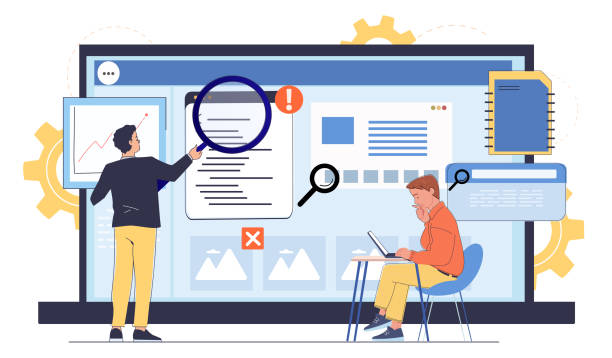
The future of #User_Interface and User Experience design is rapidly taking shape, with new trends emerging that will transform how we interact with the digital world.
One of the most important future trends is the deeper integration of #Artificial_Intelligence (AI) and Machine Learning (ML) into user interfaces.
These technologies enable websites and applications to provide a personalized and intelligent user experience.
From advanced chatbots to product recommendations based on user history, AI can make the user interface more predictive and proactive.
In this regard, the development of #Voice_UI and conversational interfaces is also of high importance.
With the increasing use of voice assistants like Siri, Alexa, and Google Assistant, users expect to be able to interact with websites and online services through voice as well.
This requires a complete rethinking of how user processes and navigation are designed.
Another trend is the expansion of Virtual Reality (VR) and #Augmented_Reality (AR) in web user experience.
While still in early stages, these technologies have the potential to create immersive and entirely new experiences.
Imagine viewing a product in 3D in your actual space or exploring an online store in a virtual environment.
These technologies blur the boundaries between the physical and digital worlds.
Additionally, designs based on “Dark Mode” and “Microinteractions” are also maturing and gradually becoming new standards in Modern Website Design with a Modern User Interface.
These #News trends indicate that the future of UI/UX goes beyond mere visual and functional aesthetics and moves towards creating fully personalized, immersive, and intuitive experiences.
For a deeper understanding of AI’s role in user experience, you can refer to specialized articles in the field of AI in UX.
These developments require developers and designers to constantly stay updated and adapt to new technologies.
Successful and Inspiring Examples of User-Friendly UI Design

To better understand the concept of a Modern Website Design with a Modern User Interface, examining #Successful and #Inspiring_Examples in the real world is very beneficial.
These #Case_Studies not only demonstrate how #Best_Practices are implemented but can also provide innovative ideas for future projects.
Websites like Airbnb, Spotify, and Google are pioneers in providing unparalleled user experiences.
Airbnb, with its very clean and intuitive user interface, has made the process of searching and booking accommodation incredibly simple and pleasant.
The use of high-quality images, clear navigation, and step-by-step processes allows users to confidently use the services.
Spotify is a prominent example of personalization and content discovery.
Its user interface, emphasizing simplicity and efficiency, provides easy access to millions of songs, and its recommendation algorithms significantly enhance users’ listening experience.
These websites, through intelligent use of colors, typography, and whitespace, offer a visually pleasing and functional experience.
Google, with its minimalist design and focus on search functionality, has set the standard for web UI design for years.
The simplicity of its homepage, while concealing the power and complexity of its infrastructure, is an excellent example of efficient design.
These companies continuously optimize and test their user interfaces to ensure they are always at the peak of efficiency and attractiveness.
From an #Analytical perspective, the success of these websites is due not only to their technical capabilities but also to their unwavering focus on user needs and behaviors.
They clearly demonstrate how a user-friendly and modern user interface can become the cornerstone of a digital business’s success.
Studying these websites and other prominent examples can help designers gain a deeper understanding of what truly works and inspire their future projects.
For more examples of successful designs, you can refer to websites like Awwwards or The Webby Awards, which showcase the best web designs.
| Website/Service Name | Industry | Prominent UI/UX Features | Reason for Success |
|---|---|---|---|
| Airbnb | Accommodation Booking | High-quality images, Simple booking process, Intuitive navigation | Flawless user experience in search and booking, Increased user trust |
| Spotify | Music Streaming | Strong personalization, Clean and dark UI, Easy access | New content discovery, Smooth and pleasant listening experience |
| Google Search | Search Engine | Minimalism, High loading speed, Relevant and fast results | Unparalleled efficiency, Instant access to information |
| Slack | Team Communication | Colorful and efficient design, Advanced search capabilities, Customizable notifications | Improved team collaboration and productivity |
| Medium | Content Publishing Platform | High readability, Clean and distraction-free design, Focus on content | Enjoyable reading experience, Simple UI for writers |
The Role of User Research in Optimizing UI Design

In the process of Modern Website Design with a Modern User Interface, #User_Research is a vital and indispensable step.
This #Specialized and #Explanatory approach helps designers make decisions based on real data and deep insights about users, rather than guesswork.
Without a proper understanding of users’ needs, behaviors, and pain points, even the most beautiful designs may fail.
User research includes a set of methods, such as interviews, surveys, focus groups, and #Usability_Testing.
These methods allow designers to view the product from the user’s perspective and identify obstacles and challenges they experience during interaction with the user interface.
For example, in the design process, creating #User_Personas based on data collected from real users helps designers have a clear and tangible picture of their target users.
Each persona represents a group of users with common characteristics, needs, and goals.
These personas will guide decision-making throughout all stages of design, from color and font selection to information architecture and user flow.
Also, usability testing with real users is one of the most effective ways to identify problems in the user interface.
By observing users while performing specific tasks on the website, designers can discover design weaknesses that they might never have considered.
This direct feedback is essential for continuous design optimization and improvement.
Ignoring the user research phase can lead to designing products that do not meet real market needs and, consequently, result in commercial failure.
Investing in user research is, in fact, an investment in the long-term success of the product and customer satisfaction.
For more information on the importance of user research, you can refer to articles on Why You Need User Research? at the Nielsen Norman Group.
This comprehensive approach ensures that the final design is not only beautiful but also fully functional and effective.
How much does losing business leads due to an unprofessional site cost you? With professional corporate website design by Rasaweb, solve this problem forever!
✅ Increase credibility and trust of potential customers
✅ Easier acquisition of new business leads
⚡ Get a free consultation now!
Optimizing Performance and Speed in Modern User Interfaces
![]()
In today’s digital world, where users expect incredible #Loading_Speed from websites, #Performance_Optimization in a Modern Website Design with a Modern User Interface is more crucial than ever.
Advanced user interfaces often include complex animations, high-resolution images, and heavy JavaScript scripts, which, if not properly optimized, can lead to slow website performance and a poor user experience.
The goal of performance optimization is to make your website fully visible and interactive in the shortest possible time.
One of the most important factors is image optimization.
Using appropriate image formats (like WebP) and compressing them without noticeable loss of quality can significantly reduce page size.
Additionally, lazy loading of images and videos, which are only loaded when the user scrolls to them, has a significant impact on initial loading speed.
Reducing the size of CSS and JavaScript codes through Minification (removing whitespace and extra characters) and Compression (compressing files) are other effective methods.
Also, using Content Delivery Networks (CDNs) to host static assets (images, CSS, JS) from servers closer to users can significantly reduce latency.
Furthermore, paying attention to Google’s Core Web Vitals metrics, which include LCP (Largest Contentful Paint), FID (First Input Delay), and CLS (Cumulative Layout Shift), is very important for improving SEO ranking and user experience.
These metrics represent how users perceive the performance of a web page.
For example, improving FID means the website responds faster to the user’s first interaction, which creates a good psychological feeling.
This #Specialized and #Guidance section helps developers build fast and responsive websites using advanced techniques.
Implementing server-side and client-side Caching can also ensure that repetitive requests are retrieved from the cache instead of being reloaded from the server, which dramatically increases speed.
Finally, conducting regular performance tests with tools like Google PageSpeed Insights or Lighthouse is essential to identify bottlenecks and performance weaknesses.
Practical Steps for Implementing Modern Website Design with a Modern UI
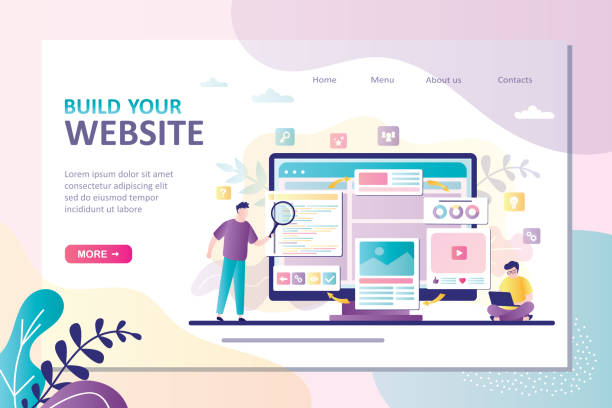
After gaining a deep understanding of the concepts, principles, tools, and challenges of Modern Website Design with a Modern User Interface, it’s time for practical steps.
This #Educational and #Guidance section will help you create a roadmap for successfully implementing a modern user interface.
The first step is #Comprehensive_Planning and research.
This includes defining website goals, accurately identifying target audiences (through personas), and competitor analysis.
Understanding user needs and expectations is the cornerstone of any successful design.
Without this stage, there is a risk of building a product that no one needs.
The second step is designing wireframes and prototypes.
Wireframes are initial, simple layouts that define the structure and arrangement of content, while prototypes are more interactive versions of the design that allow for testing user flow and gathering initial feedback.
At this stage, the focus is on ease of use and intuitive navigation.
The third phase is visual design, which includes selecting the color palette, fonts, images, and icons.
At this stage, it must be ensured that the design is not only beautiful and appealing but also consistent with your brand and correctly conveys your message.
Using modern design styles such as Flat Design or Material Design can help create a fresh and up-to-date look.
The fourth step is the #Implementation or development phase.
In this stage, designers and developers collaborate to transform designs into executable code (HTML, CSS, JavaScript).
Using modern frameworks and adhering to best coding practices is essential for building a high-performance and maintainable website.
Also, ensuring the design is responsive across various devices is crucial at this stage.
The final step is #Continuous_Maintenance and optimization.
The web world is constantly changing, and to maintain website relevance and efficiency, updates and improvements must be applied regularly.
Gathering user feedback, analyzing website traffic data (using tools like Google Analytics), and conducting A/B tests can help identify weaknesses and opportunities for improvement.
This cyclical approach ensures that your website is always evolving and improving to provide the best possible experience to users.
Frequently Asked Questions
| No. | Question | Answer |
|---|---|---|
| 1 | What does a modern user interface mean in website design? | It means designing a website that has a beautiful, attractive, and up-to-date appearance, while also being easy, intuitive, and enjoyable for the user to interact with (emphasis on UX/UI). |
| 2 | What are the main features of a modern user interface? | Includes minimalist design, sufficient use of whitespace, appealing typography, a harmonious color palette, high-quality images and icons, full responsiveness, high loading speed, and appropriate use of animations and micro-interactions. |
| 3 | Why is having a modern user interface important for a website? | It leads to improved user experience, increased visitor trust, reduced bounce rate, increased user time on site, strengthened brand, and ultimately helps achieve business goals (such as sales or user acquisition). |
| 4 | What is the role of Responsive Design in a modern user interface? | Responsiveness is a crucial component; a website with a modern user interface must display correctly and function optimally across all devices (mobile, tablet, desktop). |
| 5 | How does typography (font selection) affect a modern user interface? | Appropriate typography increases readability, defines information hierarchy, and plays a significant role in creating a modern visual aesthetic that aligns with brand identity. |
| 6 | What is the importance of using Whitespace in modern design? | Whitespace allows visual elements to “breathe,” prevents clutter, enhances user focus on the main content, and creates a clean and professional appearance. |
| 7 | What role do Micro-interactions play in improving a modern user interface? | Micro-interactions (such as a button changing color on click, displaying a form submission success message) provide visual feedback to the user, make site usage more interactive and enjoyable, and convey a sense of attention to detail. |
| 8 | What tools are used for modern user interface design? | Common tools include Figma, Sketch, Adobe XD, and even Prototyping Tools. |
| 9 | How can one ensure that a modern user interface is also user-friendly (Usable)? | Through User Testing, gathering feedback from real users, adhering to Accessibility principles, and Intuitive Navigation. |
| 10 | Does modern design mean removing all graphical elements? | No, being modern means the intelligent and purposeful use of graphic elements, colors, images, and animations to create an appealing yet functional experience, not their unnecessary removal. |
And other services of RasaWeb Advertising Agency in the field of advertising
Smart Sales Automation: A fast and efficient solution for increasing click-through rates with a focus on Google Ads management.
Smart Advertising Campaign: An innovative service for increasing customer acquisition through marketing automation.
Smart Digital Advertising: An effective tool for digital branding with the help of user experience customization.
Smart Customer Journey Map: A fast and efficient solution for campaign management with a focus on custom programming.
Smart SEO: A creative platform for improving online growth with intelligent data analysis.
And over a hundred other services in the field of internet advertising, advertising consultation, and organizational solutions
Internet Advertising | Advertising Strategy | Advertorials
Resources
Modern UI Web Design Guide on Websima
Latest UI/UX Trends on Roocket
Importance of UI/UX in Web Design on Iranserver
How to Create a User-Friendly UI on Toplearn
? For your business to leap in the digital world and reach peak success, Rasaweb Digital Marketing Agency, specializing in e-commerce website design and comprehensive marketing strategies, is here to accompany you in experiencing a powerful and profitable presence.
📍 Tehran, Mirdamad Street, next to Bank Markazi, Kazerun Jonoubi Alley, Ramin Alley, No. 6

